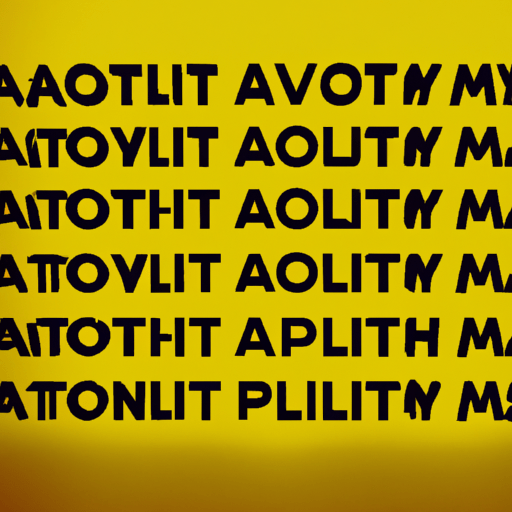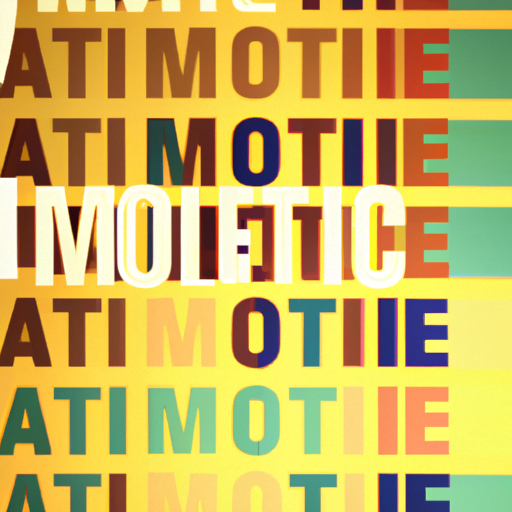
-
Table of Contents
- Kinetic Typography: Adding Movement to Text-based Artworks
- What is Kinetic Typography?
- The Benefits of Kinetic Typography
- Examples of Kinetic Typography in Action
- 1. Apple’s “Think Different” Campaign
- 2. Opening Titles of “Catch Me If You Can”
- 3. Music Videos
- How to Create Effective Kinetic Typography
- 1. Choose the Right Font
- 2. Plan the Motion
- 3. Use Animation Techniques
- 4. Sync with Audio
- Conclusion
Kinetic Typography: Adding Movement to Text-based Artworks

Typography is an essential element in design, allowing artists and designers to convey messages and evoke emotions through the arrangement and style of text. However, traditional static typography can sometimes lack the impact and engagement needed to capture the attention of modern audiences. This is where kinetic typography comes into play. Kinetic typography adds movement and animation to text-based artworks, creating a dynamic and captivating visual experience. In this article, we will explore the concept of kinetic typography, its benefits, and how it can be effectively used in various contexts.
What is Kinetic Typography?
Kinetic typography, also known as motion typography or animated typography, is the art of animating text to create visually appealing and engaging designs. It involves adding movement, transitions, and effects to individual letters, words, or phrases, transforming static text into a dynamic and interactive visual experience.
With the advancements in technology and software tools, kinetic typography has gained popularity in various fields, including advertising, film and television, music videos, and digital media. It allows designers to bring text to life, enhancing the overall impact and effectiveness of the message being conveyed.
The Benefits of Kinetic Typography
Kinetic typography offers several benefits that make it a powerful tool for visual communication:
- Enhanced Engagement: Adding movement to text captures the viewer’s attention and keeps them engaged. It creates a sense of dynamism and excitement, making the message more memorable.
- Improved Comprehension: Motion can help convey complex ideas or concepts more effectively. By animating specific words or phrases, designers can emphasize key points and guide the viewer’s understanding.
- Increased Emotional Impact: Kinetic typography allows designers to evoke emotions through the use of motion, timing, and visual effects. It can create a sense of urgency, playfulness, or drama, depending on the intended message.
- Enhanced Storytelling: By animating text, designers can add another layer of storytelling to their visuals. The movement of the text can complement the narrative, enhancing the overall storytelling experience.
- Brand Differentiation: Kinetic typography can help brands stand out in a crowded marketplace. By incorporating animated text into their marketing materials, companies can create a unique and memorable brand identity.
Examples of Kinetic Typography in Action
Let’s explore some real-world examples of how kinetic typography has been effectively used:
1. Apple’s “Think Different” Campaign
Apple’s iconic “Think Different” campaign featured a series of advertisements showcasing influential figures from various fields. The kinetic typography used in these ads added movement and energy to the text, reinforcing the message of thinking differently and challenging the status quo.
2. Opening Titles of “Catch Me If You Can”
The opening titles of the movie “Catch Me If You Can” are a prime example of kinetic typography. The animated text, combined with the jazzy soundtrack, sets the tone for the film and creates a visually captivating introduction.
3. Music Videos
Many music videos incorporate kinetic typography to enhance the visual experience and complement the lyrics. Artists like Taylor Swift, Coldplay, and OK Go have used animated text to create visually stunning and memorable music videos.
How to Create Effective Kinetic Typography
Creating effective kinetic typography requires careful planning and execution. Here are some key steps to consider:
1. Choose the Right Font
The font you select plays a crucial role in the overall impact of your kinetic typography. Choose a font that aligns with the message and tone you want to convey. Consider factors such as readability, style, and compatibility with animation effects.
2. Plan the Motion
Before diving into the animation process, plan out the motion and transitions you want to incorporate. Consider the timing, pacing, and overall flow of the text. Storyboarding or sketching out the animation can help visualize the final result.
3. Use Animation Techniques
There are various animation techniques you can employ to bring your kinetic typography to life. These include scaling, rotation, fading, and morphing. Experiment with different effects to find the ones that best enhance your message.
4. Sync with Audio
If your kinetic typography is accompanied by audio, synchronize the motion with the sound. Align specific words or phrases with the beats or rhythm of the music to create a cohesive and immersive experience.
Conclusion
Kinetic typography is a powerful tool for adding movement and animation to text-based artworks. It enhances engagement, improves comprehension, and increases emotional impact. By effectively using kinetic typography, designers can create visually captivating and memorable experiences for their audiences. Whether it’s in advertising, film, music videos, or digital media, kinetic typography has the potential to transform static text into dynamic visual masterpieces.
